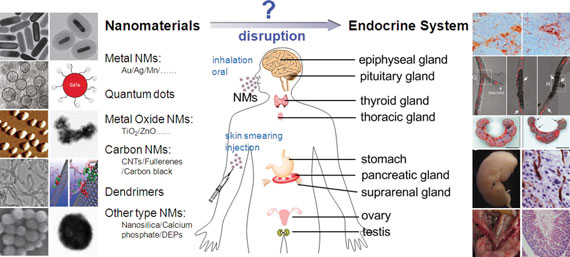| Posted: Feb 18, 2013 | |
Nanotoxicity research needs to target the endocrine system |
|
| (Nanowerk Spotlight) The purpose of the emerging field of nanotoxicity is to recognize and evaluate the hazards and risks of engineered nanomaterials and evaluate safety. Today, we don't even know what the impact of most chemicals is, and that includes products that have been produced by industry for many years. Nevertheless, a general understanding about nanotoxicity is slowly emerging as the body of research on cytotoxicity, genotoxicity, and ecotoxicity of nanomaterials grows. | |
| A new review published in the February 11, 2013 online edition of Small ("Nanotoxicity: A Growing Need for Study in the Endocrine System") summarizes and discusses recent reports derived from cell lines or animal models concerning the effects of nanomaterials on, and their application in, the endocrine system of mammalian and other species. | |
| Currently, existing data and knowledge of potential endocrine interactions and toxicities are quite limited. A hugely complicating factor is that, due to intrinsic differences in the metabolism, sensitivity, and regulation of the endocrine systems of the different animal models, it is questionable if such knowledge can be extended to other in vivo systems – especially human. This question is further confounded by the possible differences in the biodistribution and efficiency of delivery of nanomaterials in different models. | |
| The authors argue that many questions as to whether engineered nanomaterials pose risks to the endocrine system – the system of glands, each of which secretes different types of hormones directly into the bloodstream. Studies of reproductive function suggest that exposure to some nanomaterials may disrupt endocrine functions such as regulation of serum sex hormone levels. In contrast, other nanomaterials may prevent endocrine dysfunction via various mechanisms, including antioxidant effects. Hence, systematic biosafety assessment is necessary to evaluate the potential endocrine-disrupting risks of nanomaterials. | |
 |
|
| The schematic interaction between nanomaterials and endocrine system. (Reprinted with permission from Wiley-VCH Verlag) | |
| The authors, led byTao Zhu, a professor at the University of Science & Technology of China, first look at various categories of nanomaterials and explore the body of research with regard to their effects on endocrine functions. | |
| Metal-based nanomaterials | |
| Some recent studies presented evidence that metal nanomaterials (in particular gold, silver and manganese nanoparticles), widely used in the consumer market, may exert endocrine-associated toxicity. | |
| Quantum dots | |
| Several studies are quoted with regard to observed effects of quantum dots on reproductive dysfunction, TH signalling, estrogen receptor activation, and endocrine disrupting activity. Although there is clear evidence that certain CdTe quantum dots may act as endocrine disrupters, the authors suggest that further studies are required to come to conclusive findings. | |
| Metal-oxide nanoparticles | |
| It appears that metal oxide nanoparticles, widely used as industrial catalysts, may have differential effects depending on the particular animal models utilized and/or the endocrine organs examined. Studies have found that TiO2 nanoparticles might impair insulin response in Fao cells, and might result in pregnancy complications in animal models. Other metal oxide nanoparticles have been reported to exert adverse effects on reproductor and neonatal development. | |
| Carbon-based nanomaterials | |
| This category, which includes graphene, nanotubes, fullerenes, nanodiamonds, and carbon black, is one of the key research areas of nanotechnologies. Their potential applications range from biomedicine, to nanoelectronics, to mechanical engineering. Thus, there is a pressing need to evaluate the possible endocrine risks associated with carbon-based nanomaterial exposure. | |
| Despite numerous research efforts, the jury is still out as to how, when and what toxicological effects carbon nanomaterials possess. It also remains unclear whether carbon nanomaterials may exert direct effects on the endocrine system. | |
| The study of nanotoxic effects in the endocrine system, as generally is the case with nanotoxicity research, is vastly complicated as the adverse effects of nanoparticles on human health often depend on their physicochemical properties – chemical structure, size, shape, functionalization, and agglomeration state. Adverse effects cannot be generalized and often also depend on the specific endocrine tissue or cell types. | |
| Concluding their review, the author team support the proposal that nanotoxicity testing should cover the physicochemical characterization of nanomaterials or nanoparticles together with in vitro and in vivo studies. "As for the endocrine toxicity, further multiple parameters such as the age and period of exposure to nanoparticles, and the potential epigenetically mediated intergenerational effects should also be taken into consideration. Moreover, mechanisms of potential nanotoxicity in the endocrine system remain largely unexplored. Endocrine-related systems or organs, in addition to those involved in reproduction, should be targeted for future investigation." | |
 By
Michael
Berger
– Michael is author of three books by the Royal Society of Chemistry:
Nano-Society: Pushing the Boundaries of Technology,
Nanotechnology: The Future is Tiny, and
Nanoengineering: The Skills and Tools Making Technology Invisible
Copyright ©
Nanowerk LLC
By
Michael
Berger
– Michael is author of three books by the Royal Society of Chemistry:
Nano-Society: Pushing the Boundaries of Technology,
Nanotechnology: The Future is Tiny, and
Nanoengineering: The Skills and Tools Making Technology Invisible
Copyright ©
Nanowerk LLC
|
|
|
Become a Spotlight guest author! Join our large and growing group of guest contributors. Have you just published a scientific paper or have other exciting developments to share with the nanotechnology community? Here is how to publish on nanowerk.com. |
|
